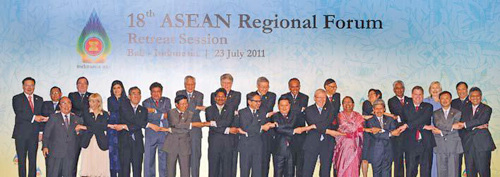|
 |
|
JOINING HANDS: Foreign ministers and representatives attending the ASEAN Regional Forum Foreign Ministers' Meeting pose for a photo in Bali, Indonesia, on July 23 (CHEN DUO) |
Zhang Jiuhuan, a diplomat who previously served as China's ambassador to countries including Singapore and Thailand.
It was agreed at the meetings, since 2011 marks the 20th anniversary of dialogue between China and ASEAN countries and 2012 marks the 10th anniversary of the signing of the DOC, the parties should make the best of this opportunity to make cooperation the central theme of South China Sea discussions.
China and ASEAN countries pledged in the DOC they would carryout cooperation in marine environmental protection, scientific research, navigation safety, search and rescue and combating transnational crimes before reaching a comprehensive and permanent settlement of the South China Sea dispute.
Since the signing of the DOC, China and ASEAN countries, guided by its purpose and principles, have maintained close communication and active discussions on cooperation. They have held two senior officials' meetings, and set up a joint working group, which has held six meetings.
During the meetings, the two sides decided to conduct six cooperative projects such as disaster prevention and mitigation, marine search and rescue and scientific research in the South China Sea, of which China and ASEAN countries will each undertake three projects.
The follow-up actions to the implementation of the DOC have become an important platform for China and ASEAN countries to continue dialogue and cooperation concerning the South China Sea, and have played an irreplaceable role in maintaining stability in the area and deepening the China-ASEAN strategic partnership, said China's Foreign Ministry.
Maintaining cooperation
The heated dispute in recent months produced negative impacts on China-ASEAN relations, said Jin Canrong, Associate Dean of the School of International Studies at Renmin University of China.
Jin told Beijing Review Viet Nam and the Philippines adopted a number of strategies to gain an advantage. These include uniting to negotiate with China; turning the South China Sea dispute into a problem between China and the whole of ASEAN; making the dispute international and submitting it to the UN; and seeking support from the United States.
Presently, China is dealing with the issue cautiously, trying to prevent it from being changed into a problem between China and the whole of ASEAN, said Jin.
Su Hao, a researcher on Asia-Pacific studies with the China Foreign Affairs University, said ASEAN integration is currently the most important task for member countries, and China strongly supports this. This major task should not be stopped by the South China Sea dispute. Cooperation will remain the mainstream of future China-ASEAN relations, Su said.
Some ASEAN countries' inviting U.S. intervention has violated the provisions of the DOC, which forbid behavior complicating and escalating disputes, and affecting peace and stability, he said. Their attempts may hinder progress in the flourishing China-ASEAN cooperation. China and ASEAN enjoy a sound foundation of cooperation. On January 1, 2010, the China-ASEAN Free Trade Area was launched as the biggest free trade area among developing countries. In 2010, trade volume hit $292.78 billion, a 37-fold increase over 1991. China is ASEAN's biggest trade partner, and ASEAN has replaced Japan as China's third largest trade partner.
By the end of June, two-way investment between China and ASEAN had reached nearly $80 billion, of which China's investment in ASEAN countries had totaled $13 million, said China's Ministry of Commerce.
China and ASEAN countries are geographically close and their economies are highly complementary. The two sides' efforts to establish mutual trust through dialogue, jointly solve shared problems and deal with the global crisis are conducive to stability and development in the region and beyond, said Huang Xingyuan, Secretary General of the Chinese People's Institute of Foreign Affairs.
Given their lasting and solid relationships, the two sides should uphold the spirit of cooperation, rather than fall into wrestling over contentious issues such as the South China Sea, Huang said.
| 